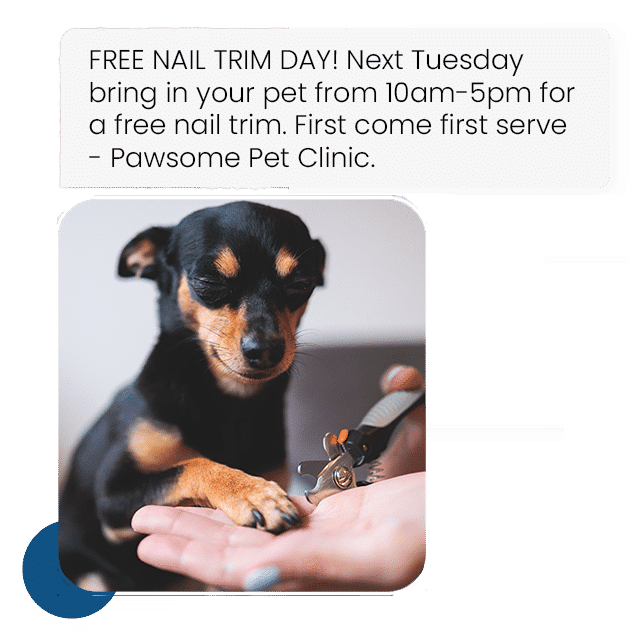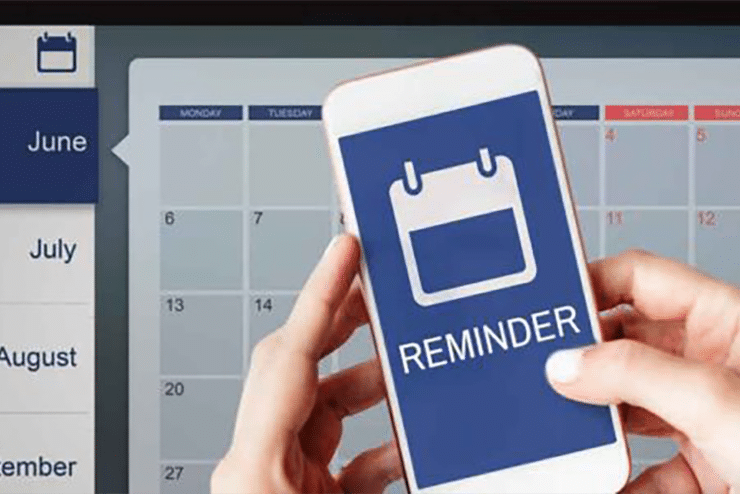
How to Boost Your Text Campaigns Using MMS Marketing
If you’re a business owner used to sending out plain text messages, you might wonder if it’s worth switching things up.
Do you know your marketing messages could be more than just text?
What if they could include vibrant images, engaging videos, or even catchy audio clips that grab your audience’s attention right away? That’s where MMS marketing comes in.
In this article, we’ll discover everything about MMS marketing and explore why many businesses are starting to use it. Let’s see how this tool can help you connect with your customers!

Get Started With Business Texting
View our pricing, and start your free trial with Textellent today!
What is MMS Marketing?
MMS (Multimedia Messaging Service) marketing is a powerful tool that allows businesses to send multimedia content directly to customers’ mobile phones.

Unlike traditional SMS marketing, which is limited to text only, MMS includes images, animated GIFs, videos, audio, and even slideshow presentations. This capability allows for a richer and more engaging experience for the recipients.
Difference Between SMS and MMS Messages
First of all, let’s break down the difference between SMS and MMS.
SMS is limited to text-only messages. Also, if you need to send longer messages (more than 160 characters), they may be split into multiple texts, which can be less engaging and harder to read.
Meanwhile, MMS allows for multimedia content. You can send images, videos, audio files, and even slideshows. This makes MMS messaging much more versatile and engaging compared to SMS.
SMS marketing costs between $0.01 and $0.06 per message. Many mobile plans include a certain number of SMS messages for free or at a very low cost.
MMS messages are more expensive because they use more data to send multimedia content.
So, what can you expect to pay for an MMS message?
Generally, MMS messages typically cost can range anywhere from $0.03 to $0.10 per message in the United States, but MMS messages cost varies depending on a few key factors:
- Costs depend on the carrier; some charge flat rates, others vary by message size or time
- Sending more messages lowers the per-message cost
- Larger files can increase costs, so keep MMS sizes under 600 KB
- Subscriptions offer set costs; pay-as-you-go is flexible for occasional use
- Add-ons like scheduling or analytics may have extra fees
The more MMS or SMS messages you send, the higher your costs will be. However, many service providers offer volume discounts, so sending more messages can lower the cost per message.
That’s why your choice of MMS marketing service provider can impact the cost, but the level of engagement is higher, so it may be worth the investment.
Different providers offer various features and pricing plans, so it’s important to compare options to find the best fit for your budget.
With Textellent, you’ll get impactful multimedia messaging with flexible pricing options, volume discounts, and features like scheduling and analytics to maximize your budget.
Sign up for a free trial or request a demo consultation today!
Benefits of MMS Marketing Over Traditional SMS
MMS marketing offers several advantages over traditional SMS marketing, such as:
Visual Appeal
One of the biggest advantages of MMS marketing over traditional SMS marketing is its visual appeal. Visuals can convey information more effectively than text alone.
For example, a picture of a product can highlight its features better than a text description ever could.
Higher Engagement Rates
MMS messages often have higher open rates because they promise richer content. People are likely to open a message containing an interesting image or video.
The engaging nature of MMS content can also lead to higher click-through rates. If recipients are intrigued by the multimedia content, they are more likely to click on a link within an MMS message.
Also, people spend more time viewing MMS messages when they include visual and audio elements.
Enhanced Brand Experience
Creating a strong brand experience is crucial for customer retention and loyalty. Branded visuals in your MMS messages can reinforce your brand’s identity and create a more consistent customer experience.
High-quality multimedia content can also present your brand more professionally, helping you build trust and credibility with your audience.
Increased Conversion Rates
Rich media allows for more compelling and visually appealing CTAs, which can drive higher response rates. Videos and images can more effectively showcase the value of your products or services, leading to increased sales.
MMS’s visual and interactive nature can prompt immediate actions from recipients, such as clicking a link, purchasing, or contacting your business.
How Businesses Use MMS for Marketing
Businesses can use MMS to improve their communication efforts in multiple ways. Below, we explore some MMS marketing examples where they’re particularly effective.
Product Launches and Announcements
MMS marketing is perfect for announcing new products or services. Businesses can create buzz and excitement around a new launch by sending multimedia messages, including images, videos, or audio descriptions.
For example, a fashion brand can send an MMS showcasing a new clothing line with high-quality images and a video lookbook.
Seasonal Promotions and Special Offers
Seasonal promotions and special offers can greatly benefit from the visual appeal of MMS messages.
Businesses can send visually rich messages highlighting discounts and special deals during holidays or special sales events.
For example, a restaurant might use MMS to send a festive video with a discount code for holiday dining.
In-store Promotions
Use MMS to boost in-store promotions by sending exclusive offers to customers nearby or recently visiting your store.
For instance, send an MMS with a discount code or coupon to customers within a certain distance of your store.
Event Invitations and Reminders
MMS is an excellent medium for sending event invitations and appointment reminders. The multimedia content can make the invitation more attractive and informative.
For example, a business hosting a webinar can send an MMS with a brief video invitation, event details, and a link to register.
Customer Engagement and Feedback
Engaging customers through MMS can be more interactive and fun. Businesses can send surveys, polls, or contests via MMS to gather feedback and keep customers engaged.
For example, a retail store could send an MMS survey after a purchase to get customer feedback on their shopping experience.
Product Demonstrations
MMS can be used to send product demonstration videos that show how to use a product effectively. This can be particularly useful for complex products that require some explanation.
For instance, a tech company might send an MMS with a video tutorial on how to set up a new gadget.
MMS Marketing Best Practices
It’s essential to create content that captures and retains your audience’s attention to maximize the effectiveness of your MMS marketing. Here are some tips for designing effective MMS messages:
Creating Compelling Content
Focus on creating content that grabs and holds your audience’s attention. High-quality visuals are essential. Use clear, high-resolution images and videos. Avoid blurry or low-quality visuals, which can make your brand look unprofessional.
Even though MMS allows for more content than SMS, keep your message concise. Avoid cramming too much information into one message, and include a strong, clear, and compelling call to action.
Whether you want recipients to visit your website, use a discount code, or watch a video, make it easy for them to take action.
Ensure your images and videos are optimized for mobile viewing by keeping file sizes small for quick loading and ensuring they look good on all screen sizes.
Personalization and Segmentation
Personalized and targeted messages tend to perform better. Segment your audience into groups based on demographics, purchase history, and behavior, allowing you to send more relevant messages.
Ensure that you’re using customer data to personalize your messages. For example, address recipients by name and tailor the content to their interests or past interactions with your brand.
Implement dynamic content that changes based on the recipient’s profile, such as personalized product recommendations or localized offers.
Timing and Frequency
The timing and frequency of your MMS messages can significantly impact their effectiveness. Generally, the best times to send MMS messages are during lunch (12 PM to 1 PM) and early evening (5 PM to 7 PM).
However, it is important to test different times to see when your audience is most responsive.
To prevent customer irritation and increased opt-outs, avoid sending too many messages in a short period. Limiting MMS messages to 1-2 times per week is a good rule of thumb.
Interactive MMS Campaigns
MMS marketing is excellent for interactive campaigns. You can send surveys or polls to gather customer feedback or insights. Using images or quick videos can make the process more engaging.
Another effective strategy is to promote contests or giveaways with MMS.
Encourage recipients to participate by sending photos or videos as entries. You may also request customer feedback on products or services through MMS.
Ensuring Compliance and Legal Considerations
Following legal guidelines is crucial to avoid issues. Be aware of regulations such as the Telephone Consumer Protection Act (TCPA) in the United States.
Always obtain explicit consent from recipients before sending MMS messages for marketing purposes. This can be done through a simple opt-in process where customers submit their consent via webform, texting in, etc.
Also, make it simple for recipients to opt out of receiving your messages by including clear instructions in each MMS.
Measuring the Success of MMS Marketing Campaigns
It is important to track specific Key Performance Indicators (KPIs) to measure the success of your MMS marketing campaigns.
These metrics help you understand how well your campaigns are performing and where improvements can be made.
Once you have collected data from your MMS campaigns, the next step is to analyze and interpret it to make informed decisions.
Use analytics tools provided by your MMS marketing software to gather data on your campaigns. These tools often offer detailed reports on open rates, click-through rates, and other KPIs.
Moreover, look for patterns and trends in your data. For example, you might find that messages sent on certain days or times have higher engagement rates.
How To Start MMS Marketing With Textellent
Here’s how to begin and effectively utilize Textellent’s features to ensure your business presents a professional and consistent image.
Sign Up for Textellent
Sign up for an account on Textellent. Choose a pricing plan that fits your business needs.
Textellent offers various plans, so whether you’re a small business or a large enterprise, you can find a plan that works for you.
Set Up Your Profile
Once you’ve signed up, complete your profile by adding your business information. This includes your company name, contact details, and logo.
A complete profile helps make your messages look professional and consistent with your brand. The Textellent team will take you through a simple onboarding process.
Import Your Contacts
Next, import your contact list into the Textellent platform. Make sure you have obtained consent from all recipients to receive MMS messages.
You can usually do this through a CSV file upload or by integrating with your existing CRM system.
Create Your Campaign
Now, it’s time to create your first MMS campaign. Design your message using Textellent’s Drip Campaign feature and extensive media library.
Choose from high-quality images and videos to make your message engaging.
Add your text to provide context and details. Keep your content concise and focused, and include a strong call to action (CTA) to prompt your recipients to take the desired action.
Personalize Your Message
Personalization is key to effective MMS marketing. Use Textellent’s personalization options to tailor your message to each recipient.
For example, you can include the recipient’s name, location, company name, store manager’s name, and more to make the message more relevant and engaging.
Set Up Automation
Set up automated campaigns using Textellent to save time and ensure your messages are sent at the optimal times.
You can schedule messages to go out at specific times or set up triggers based on customer actions and purchase history.
Preview and Test
Before sending out your campaign, preview your MMS message to ensure it looks good on different devices.
Send test messages to yourself to check for any issues. This step is crucial to ensure everything works as expected and looks professional.
Launch Your Campaign
Once you’re happy with your message, it’s time to launch your campaign. Click the send button and monitor the performance using Textellent’s analytics tools.
Look at open rates, click-through rates, and any other key metrics.
Analyze Results
After your MMS marketing campaign has been sent, review the analytics to see how it performed.
Look at which segments of your audience responded best and which content was most engaging. Use this data to make adjustments and improve your future campaigns.
Engage and Convert with Multimedia Messages Using Textellent
Level up your marketing results with Textellent! The platform’s easy setup and customization options allow you to boost customer interactions beyond basic text messages.
Textellent is built to make your messages more impactful by combining smart automation, rich personalization, and dynamic multimedia.
Create stunning campaigns filled with videos, images, and GIFs that captivate and leave a lasting impression.
Make every message a step toward stronger relationships and brand growth. Sign up for a free trial or request a demo consultation today!
FAQs About MMS Marketing
How do I optimize my MMS content for mobile devices?
To optimize MMS content for mobile devices, ensure that images are in portrait mode to make the best use of the phone’s form factor and that videos are high quality but kept to a small file size to load quickly.
You can use responsive design principles so your content displays well on different screen sizes and test your messages on various devices before sending them out.
How do I ensure my MMS messages are accessible to all recipients?
To ensure accessibility, keep your multimedia content simple and clear. Use alternative text (alt text) for images so that recipients using screen readers can understand the content. Additionally, provide a text version or a link to the same content online for recipients who may have trouble viewing multimedia messages.
What is the maximum size for MMS messages?
The maximum size for MMS marketing messages can vary depending on the carrier and service provider. Typically, they are limited to 300 KB to 600 KB. It’s important to optimize your multimedia content to fit within these limits without compromising quality.





